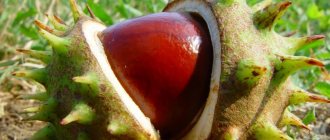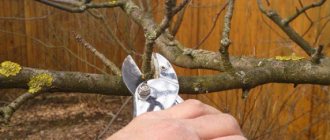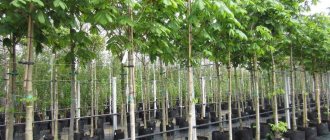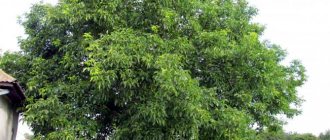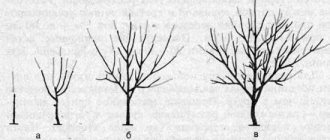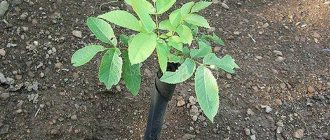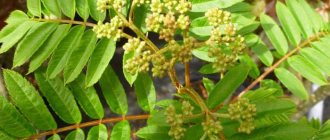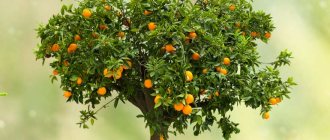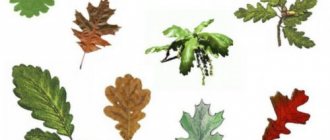- July 11, 2019
- Trees and shrubs
- KatrinGlamour
Growing chestnuts from walnuts is quite a fascinating activity that anyone can do. At home, you can easily grow an ornamental plant or a specimen that will bear fruit. True, in the process it is very important to take into account the characteristics of the tree, its planting technology and the rules for subsequent care.
Knowing how to grow chestnuts, you can easily cope with this task and will probably want to get a few more specimens planted with your own hands.
Popular varieties
Chestnut has many features, the main one of which is rapid growth in a favorable environment. In addition, the tree produces nuts until a very old age, suitable for growing new specimens.
Today more than 30 varieties of this plant are known. But you need to understand that not all types of chestnut are worth planting at home. For growing yourself, you can choose only a few varieties.
- Japanese. Famous for its growth rate. Just three years after planting, this chestnut tree begins to bear fruit, producing large edible fruits.
- Gorodchaty. Among the varieties of this tree you will not find shrubs. The crenate chestnut has a powerful trunk, which reaches 1-1.5 meters in girth.
- Chinese is the softest. Representatives of this species grow up to 15 meters in height. They have beautiful small foliage and bear edible fruit.
- American. It is famous for its resistance to temperature changes and adverse weather. Mature trees can reach 28-30 meters in height. Varieties adapted to our climate bear large, sweet fruits.
- Short. This species is represented by trees up to 12-15 meters tall with a round crown and small shrubs reaching a maximum of 2 meters. Low-growing chestnuts are famous for their unpretentiousness to the soil. They are able to grow successfully even with a lack of moisture.
- Sowing. A long-lived tree that can live for more than half a century. Seed chestnuts grow up to 35-37 meters in height. Despite the lack of exquisite taste, the fruits of this plant are also edible.
How to grow chestnut bonsai at home
The home "bonsai" is originally a dwarf, low-growing, small-leaved variety of chestnut tree. Information about the genetic properties of the plant can be found in encyclopedias or consulted with specialists at the botanical garden. They will tell you whether the project is worth starting and whether it will be successful.
Please note that the fruits of decorative chestnut varieties are inedible. In addition, homemade chestnuts rarely grow to the point where the nuts ripen, because bees do pollination, and they are inappropriate in an apartment. Self-pollinating varieties have not been bred by breeders, since they are not of particular interest (the whole “zest” is in the crown, and not in the fruits).
Dwarf chestnut grown at home
Standard care:
- prepared seeds are planted in pots in the fall;
- plants are kept on the sunny side in a warm room;
- within a year the crown begins to form;
- pruning should be done twice a year (spring and autumn), interseasonal adjustments are also permissible - only if the plant is growing vigorously;
- fertilize according to recommendations for a specific type of bonsai;
- Regular watering, avoiding excess water.
Choosing nuts for planting
How to grow chestnut? The first step is to get the nuts that you will use for planting.
- You only need to collect the fruits from the ground, since those nuts that are still growing on the tree are not suitable for planting. The most suitable time for searching for chestnuts is considered to be October or September, depending on the weather and climate.
- Nuts need to be carefully inspected. They should be smooth and even, without any roughness or bumps.
- You need to choose dark brown glossy nuts. This shade indicates the ripening of the fruit and the absence of any diseases.
- Collect as many nuts as possible. Keep in mind that not all fruits can sprout.
Choosing a variety for planting
Most often, inedible chestnuts are common in park areas. They begin to bloom in late spring. This kind of chestnut is called “horse chestnut”. In appearance it is very similar to edible. The variety of trees whose fruits can be eaten belongs to the beech family.
Almost all gardeners grow only horse chestnut. It attracts attention with its impressive crown and abundant, fragrant flowering. Horse chestnut cannot be planted in a small area, as it requires a lot of free space. In addition, it creates a fairly large shady area that many other plants will not like. It is not advisable to plant shrubs and flowers under the horse chestnut tree; it is better to put a cozy bench to hide from the scorching sun in the summer.
Chestnut varieties that are edible:
- Serrated (American). The tree is very powerful, has strong branches and a spreading crown. The bark of the tree is brown in color and has deep grooves. The height can reach more than 30 meters. The leaves are similar to hemp, pointed at the ends. In autumn, the foliage is especially beautiful, as it gathers many shades. It will perfectly complement any herbarium. The inflorescences of this variety reach 20 centimeters. Blooms in mid-summer.
The chestnuts themselves have an interesting shape. The delicate brown fruits are contained in a greenish, needle-shaped shell. There are several pieces in each. Sweet to taste. The fruits are considered a delicacy in some countries and have an impressive price.
- Sowing (European). A very tall tree that can grow over 35 meters. The trunk is massive, approximately 2 meters in diameter. This species is also called noble. The foliage of the tree is large, the lower part has a small fluffy coating. For this reason, the color of the sheets below may appear grayish. In fact, the leaves have a rich green tint. Blooms in mid-summer. The inflorescences are more like “spikelets” than “candles”; each of them reaches 35 centimeters. In mid-autumn, when the leaves gradually fall off, fruiting begins.
The fruits are hidden in a green, round, needle-shaped shell. As soon as the fruits are ripe, the clouds will burst. The fruits have a sweetish taste and are quite a fatty product. They are prepared in different interpretations. The older the tree is, the more chestnuts it will have.
- The softest (Chinese). It is considered one of the most beautiful trees among chestnuts. It reaches only 15 meters high. The foliage has a fluffy coating on the lower part. The inflorescences are small, the color palette is different. The fruits of the tree are very tasty and nutritious.
The softest crenate (Japanese). They differ in their growth rate; fruits appear within a couple of years after planting. Chestnuts are large in size, weighing up to 80 grams.
Horse chestnut is preferred for its decorative qualities. It is very easy to care for, does not require close attention, tolerates frosty weather well, and is practically not susceptible to disease. One drawback of this tree is that it grows slowly in the first decade.
The most popular horse chestnut varieties:
- Ordinary. It reaches up to 25 meters. The crown is thick and spreading, reaching up to 20 meters in diameter. The lower branches are inclined towards the ground. It blooms with white “candles” that emit an extraordinary aroma. It is an excellent honey plant.
Related article: Chinese plum description and features
Regular Pink. A distinctive feature of this variety is its rich green foliage. The inflorescences are pink. As you know, chestnuts have the ability to purify the air. It is this variety that is most often found in industrial cities with a polluted atmosphere.
Pink Small-flowered. In appearance it resembles a large bush. A very whimsical variety that prefers a warm climate and attentive care. Blooms in July, white inflorescences.
Preparation
Before planting the collected nuts, they should be properly prepared. This is a very important stage, on which the success of chestnut cultivation will largely depend.
- First of all, the planting material must be kept in damp soil or sand. Before this, the soil must undergo heat treatment for disinfection. To do this, it is convenient to use an oven, which kills any bacteria and fungi. Disinfection is mandatory, especially for sand, in which pathogenic microorganisms like to settle. It is best to carry out heat treatment in advance, since the soil still needs time to restore its beneficial characteristics, including fertility.
- The container with soil in which the nuts are planted should be placed in a cool room, such as a basement, cellar or underground. If you are growing chestnuts in an apartment, you can put the seedlings in the refrigerator. This promotes growth and greatly increases the chances of germination of the material. If you are going to plant chestnuts in the spring, then the nuts should be kept in the cold all winter. At the same time, do not forget to periodically moisten the soil.
- To plant chestnut nuts, it is advisable to use self-prepared soil. To do this, you need to mix humus and forest soil in equal proportions. It is advisable to add a little dolomite flour to the mixture. You can simply mix sand with moss. Nuts should be kept in this soil for 4-5 months before planting in open soil.
- Immediately before planting, you need to soften the shells of the fruit. Otherwise, the chestnut most likely will not germinate. Nuts should be placed in a container with clean water. The liquid will need to be changed every day, checking the condition of the chestnuts. As soon as their shell becomes soft and pliable, the planting material can be planted in the ground.
horse chestnut
Successful tree growing does not require soil with a special composition. Chestnut does not like excessive dampness, but it will not refuse fertile soil, delighting us with large palm-shaped leaves, majestic candle-shaped inflorescences, and green hedgehogs of fruit. Botanists call the majestic chestnut inflorescences thyrsus by analogy with the rod of the god Dionysus. The flowers in the inflorescence resemble bells in their shape. They are white with multi-colored spots. The shade of the spots changes over time from yellow to carmine red. At this time, the aroma that attracts bees changes. There is no nectar in red inflorescences. The most commonly grown types of horse chestnut are:
- Common (Aesculus hippocastanum). The tallest, spreading type of horse chestnut. The lower branches can hang down to the ground, forming green huts. Looks best in a loose, single fit. It is an important honey plant for collecting the famous chestnut honey.
- Pink (Aesculus x carnea). Pink inflorescences successfully emphasize the original shape and color of the tree leaves. The variety is resistant to increased air pollution; it is recommended to milk plantings in industrial areas.
- Small-flowered (Aesculus parviflora Walt). A low branched tree in the form of a shrub with original flowers that open in summer, not in spring. In parks and gardens it is used for planting next to tall trees, creating a lower tier of lush greenery.
Growing chestnuts on your own plot is effective if there is a large area that is not planned for use for other crops or buildings. The spreading crown develops well on its own and does not interfere with other plants. The grass grows poorly under the chestnut tree. But a small gazebo, bench, and table allow you to create a cozy relaxation area for the family underneath. Here, even on a hot day, you will remain fresh and cool. A beautiful tree will give the garden an elusive charm, a mysterious sophistication with its decorative effect. And you can hear many legends and poems about the healing, magical power of the tree. The chemical composition of different parts of the tree includes substances used to treat numerous diseases, both by the methods of traditional healers and by drugs produced by modern pharmaceutical industries. Among the ability to relieve pain, reduce fever, have hemostatic and antitumor properties, the ability to reduce blood viscosity is especially important. They do this with ready-made preparations, recipes for infusions, decoctions prepared from it. They are irreplaceable in the treatment of vascular diseases. Read more about the medicinal properties of chestnut in the article “The medicinal properties and contraindications of horse chestnut“
Germination, planting
You can grow a tree from seeds or ready-made seedlings. The main thing to remember is that frost is dangerous for young plants. It is recommended to cover the trunk circles of young plantings in the middle climate zones of Russia with a thick layer of foliage. Single garden plot trees can be wrapped in burlap. If frost holes appear, they must be immediately treated with an antiseptic and protected with garden varnish. Having overcome the hardships of the first years of life, the mighty tree will not be afraid of the cold. A strong seedling is obtained from root shoots, special layering, cuttings, and seeds. Ornamental plant species are often propagated by grafting. How to plant chestnut trees has been known for a long time. Experts, having studied the structure of the fruit and its properties, have mastered planting chestnuts on an industrial scale. Most often, fruits that have fallen to the ground on their own are used for this purpose. Before planting, they must undergo stratification. Under natural conditions, the process takes place during wintering in fallen leaves. In spring, the preserved chestnuts actively sprout. To plant in a designated garden bed, the fruits are collected, laid out, and mulched with a thick layer of leaves. A serious danger to chestnuts is posed by mice and other rodents, which can eat all the fruits in a fresh garden. In order not to take risks, stratification can be carried out not in the garden, but at home. To do this, the largest chestnuts are placed in a box with wet sand. Place in a cool place for the winter until spring. Before stratification, it is advisable to keep them in warm water for a week, changing it regularly. It’s even easier to collect chestnuts that have hatched under a tree in the spring and plant them in the ground, maintaining a distance of about 15 cm between plants.
It is recommended to plant a seedling that is at least three years old in a permanent place. You can use older trees, since chestnut develops poorly in the initial years of life. Its transplantation without severe damage or trauma is carried out over 10 years of development. At this time, it has compact dimensions with a root system that can be carefully placed in a large spacious hole with a depth of at least 70 cm and a width of about 60 cm. The chosen place for the tree should not contribute to stagnation of water or increased soil acidity. This causes tree diseases. To prevent them, sand drainage is made in the pit, dolomite flour and superphosphate are added. The seedling is placed on a mound made in the center of the hole, and the roots are carefully straightened. The neck is not buried, it is located above the surface of the earth. The seedlings are tied to a support and watered abundantly. After planting, it is advisable to water the seedlings daily. Often, when replanting a chestnut in the spring, the main root of the plant is shortened by a third. This improves nutritional efficiency due to the appearance of young roots growing in a horizontal plane. As a result, the crown of an adult tree grows with a spreading shape
Care
The main agrotechnical methods for growing chestnuts include weeding, watering, fertilizing, and pruning. Shallow loosening of the soil surface, weeding, and thinning must be carried out for seedlings and young plants. After the crown is formed, the need for this disappears. Weeds do not grow in the shade of a tree. The shape of the crown is monitored by destroying dried branches and excess shoots on the trunks. You need to be careful about watering your plants. In the case of hot summers, it is done more often, combined with spraying. This is due to the influence of temperature and strong wind. Chestnut leaves turn yellow, curl, and fall off prematurely. Young seedlings respond well to the addition of nitrogen fertilizers to the soil in early spring, for example, 20 g of urea per 10 liters of water. The optimal rules for caring for wood are determined by the climatic conditions of your home. You need to listen to the tree, analyze its needs, and regulate the necessary elements of care. It will definitely thank the owner with long-lasting foliage.
Growing conditions
One of the main advantages of chestnut is that it does not require any special conditions for growth. Although, of course, when receiving the maximum amount of heat and light, the tree will develop much faster and look much more beautiful. Be that as it may, the chestnut itself is not very demanding on the composition of the soil and weather conditions.
But when planting a tree, it is advisable to adhere to certain rules. Following these recommendations will harden the seedling and make it resistant to aggressive environmental influences:
- Chestnut nuts should be kept in a cold place for one or several weeks. The success of their germination will depend on this.
- How to plant chestnut? You need to bury the prepared nuts in moist soil, preferably during the rains. In cool weather and high humidity, the seedling will quickly acquire good immunity.
How to grow a chestnut tree from its fruit
Having chosen a place and prepared the planting material, you can proceed directly to planting the plant. The process itself is absolutely simple and will not take much of your time. How to plant chestnut?
- To plant one plant, it is advisable to take 6-7 nuts. Prepare holes for them in the soil no more than 5 cm deep. Don’t forget to leave a space of about 15-20 cm between the seedlings.
- Sprinkle the tops of the holes with ordinary garden soil mixed with a small amount of coarse sand.
At this point, the planting process can be considered complete. In winter, the planting material will go into hibernation. But in the spring he will need to provide full care so that the tree grows and develops quickly.
How to properly germinate chestnuts from nuts at home
An alternative way to grow a tree is to plant fruits indoors. In this case, in the future the seedling will need to be transplanted into open ground.
It is necessary to prepare planting material in the same way. But the landing process is a little different.
How to grow a chestnut seedling from a nut? This process has several main features:
- The collected nuts should be laid out in layers in a common container with moist soil, then sprinkled with wet sand and placed in the refrigerator for a couple of months.
- At the end of winter, planting material needs to be checked. By this time, all the fruits should already swell and produce the first small sprouts, due to which the shell begins to burst.
- But even if there are still no sprouts on the nuts, they can already be replanted. To do this, you will need another flowerpot with garden soil and sand mixed in equal proportions. Planting material should be planted in holes 4-5 cm deep.
- During the first two months, the soil must be moistened regularly, not allowing it to dry out.
- When the seedlings reach the thickness of at least half a little finger and the first leaves grow on them, they can already be replanted. Although gardeners advise doing this no earlier than May.
Chestnut care
When planting and in the next 4 days, regular and abundant watering is required. The tree tolerates drought well, but during dry periods young plants require increased watering. Loosening is necessary to remove weeds and saturate the soil with oxygen. In the first year of growth, in the summer, when the side shoots grow 25-30 cm in length, they need to be cut by half.
The upper side shoots that grew at the end of summer do not need to be removed. In spring, shortened branches must be pruned. The procedure must be repeated every year until the tree reaches the desired height. After this, you can leave 4-5 lateral branches to form first-order branches. If you want to grow a chestnut with a low trunk, you should select the main branches earlier. Once the trunk has been formed, there is no need for pruning, and if the crown thickens, only thin branches can be trimmed.
Drying and damaged branches are periodically pruned and the trunk is cleared of shoots. Mulching the tree trunk circle with peat, peat compost and wood chips of seedlings is mandatory. Young plants are damaged by severe frosts, so they require shelter for the winter for up to three years.
As a rule, chestnut is not susceptible to diseases. If spots appear , they should be treated with Bordeaux mixture. In early spring, the plant is fertilized. A composition of mullein, urea and ammonium nitrate diluted in water is suitable as a fertilizer.
Transfer rules
How to plant a sprouted chestnut tree? As soon as stable warm weather has established outside, you can begin replanting. Before this, it is advisable to pin the shoot so that it begins to develop faster in open ground.
- When planting several trees at once, be sure to take into account their growth characteristics. After all, they all require space around them. When replanting home seedlings, leave 2-3 meters between them.
- Be sure to protect young trees from direct sunlight.
- The depth of the planting hole should correspond to the development of the roots. The optimal size is considered to be 35-50 cm.
Most often, chestnuts are planted in one line, for example along the perimeter of the territory or near garden paths.
Growing chestnut, detailed description
Common chestnut can be propagated in several ways:
- By cuttings.
- Vegetatively.
- Seminal.
- Root shoots.
Almost always, the seed method is used for propagation. Chestnuts ripen annually, so there will be no problems finding seeds.
If a gardener decides to grow an ornamental variety at his dacha, then he cannot do without grafting.
To grow a tree from seeds, take only ripe fruits that have already fallen to the ground. They must not be damaged.
Without stratification, nuts will not be accepted. The procedure can be carried out in 2 ways:
- Natural. In November, the nuts are buried in the ground and covered well with dry leaves. There will be many shoots in the spring.
- Artificial. The fruits are placed in a well-closed container filled with moistened sand. Place in a cool place. The germination period can last from 2 to 5 months.
In the first case of stratification, there is a risk that the nuts will be damaged by various rodents. In this case, germination will suffer significantly.
5 days before planting nuts, they are immersed in warm water. It needs to be changed periodically. The chestnut skin will become a little softer and germination will be more efficient.
The fruits are buried in the soil to a depth of 8-10 centimeters.
As spring approaches, chestnuts can be planted in containers, and in May, the plants can be transplanted into open ground. At this moment, you should pinch the taproot, then the chestnut will form strong roots.
Up to 3 years old, small trees are recommended to be grown in greenhouse conditions. If the area is very cold, the time may take up to 5 years. In summer, containers with chestnuts can be taken out onto the site.
To safely plant small chestnut seedlings, you should follow these rules:
- There should be no plants or buildings on the territory within a radius of 5 meters.
- The hole for the plant is made cubic, half a meter deep.
- A dense drainage layer of 20-25 centimeters is placed at the bottom of the hole. For this you can use sand and gravel.
- It is recommended to add humus and dolomite flour mixed with soil into the planting hole. This composition is simply necessary in case of increased acidity of the soil.
- The seedling is placed in the hole carefully, with the root collar being level with the soil.
- To prevent the trunk from being exposed in the future if there is subsidence of the soil, the hole is raised slightly, by about 5-10 centimeters.
- A young seedling needs a lot of moisture, so after planting you need about 10 buckets of water.
- A temporary support made of wooden pegs will benefit the seedling. It will serve as protection in windy weather. When the roots gain strength and become stronger, the support can be removed.
- Provide the seedlings with proper care.
Where to plant a tree
It is very important to choose the right place to plant a tree. Where to plant chestnut on the plot? When choosing the optimal location, you should take into account some characteristics of the plant.
- The roots of the chestnut are shallow and grow along the ground, so you cannot deepen the plant too much. There is no need to dig a large hole for the seedling.
- Chestnut prefers moderately moist soil. But aridity and swampiness are unacceptable for him.
- As for the composition of the soil, chestnut grows best in black soil.
- An adult tree has a dense, rounded crown that provides dense shade, so other plants are unlikely to coexist next to it. And for him, close proximity is undesirable.
It is best to plant chestnuts close to the fence, leaving several approaches to it from different sides. If you have a bodega on your property, plant a tree directly above it. When it grows, it will be able to provide the necessary shade for drinks.
Features of chestnut
Horse chestnut is a deciduous tree with a dense, wide crown. In favorable conditions, its height reaches 18–25 meters. The fan-shaped leaves consist of five or seven oblong leaves, about 20–25 cm wide, and the flowers, up to 3 cm in size, are collected in candle inflorescences, 10–15 cm long. The chestnut blooms for a little more than two weeks. And in September its fruits ripen - green tricuspid spiny boxes, 6 cm in diameter, with one large seed.
Despite its southern origin, chestnut is a fairly winter-hardy, fast-growing and soil-unpretentious tree. Horse chestnut is durable . Under favorable conditions it can live up to 300 years. Chestnut is not “interesting” for pests and diseases. Mature trees tolerate replanting well. Chestnut prefers loose, deep, moderately moist soils. But what he has a bad attitude towards is hot winds - dry winds, from which the leaves turn yellow, dry out and fall off.
Chestnut is a plant so expressive that it often dictates its own conditions to us: with its appearance, the character and image of the garden changes. It looks most impressive when planted alone. The chestnut tree can simply grow on the lawn, or it can become part of the composition of the patio. The use of chestnut to create alleys is also widely practiced.
Landing Features
How to grow chestnut? In fact, it is not difficult at all, you just need to take into account some features of the tree.
The plant grows best in moist, loose, loamy soils. If you grow chestnut in another place, it needs to be provided with additional feeding. This is what caring for him will consist of.
- How to grow chestnuts in clay soil? Just add some sand to it. If this is not done, stagnation of water may occur, which will cause rotting of the roots.
- If the soil is too loose, it needs to be supplemented with clay so that the structure becomes sufficiently dense.
- When growing chestnut in depleted soil, you should add rotted manure and compost mixed with garden soil. Such soil will provide the tree with the necessary amount of nutrients.
- In autumn, you need to add a mixture of 15 grams of nitroammophoska and 10 liters of water to the soil. Nutrient feeding will give the chestnut the opportunity to easily endure the winter period.
Landing
Selecting a location
Chestnut has a wide crown. It prefers to grow in sunny places, tolerates shade well, but does not bloom well without exposure to direct sunlight.
For normal development, there should be no buildings or plants within a radius of 5 m from the chestnut tree.
Timing
Seedlings are planted in early spring or November, and sprouted nuts are planted in early May or left in the ground in the fall.
Soil preparation
Chestnut has a superficial root system.
To prevent the roots from rotting and the water from stagnating, the tree is planted in moderately moist neutral or slightly acidic loose soil with good drainage. Suitable chernozem or loamy substrate with an admixture of lime and sand. You can add a little clay to sandy soil.
Features of planting seedlings
When growing chestnuts, there should be no plants within a radius of 5 meters from the seedling.
Dig a cubic hole, 50-60 cm deep and wide.
At the bottom, lay a 30 cm thick layer of sand mixed with crushed stone. This will ensure drainage.
If necessary, add humus to the soil mixture; if there is high acidity, add dolomite flour.
When installing a seedling in a hole, make sure that the root collar is at soil level.
To avoid exposing the trunk, make the planting hole 10 cm higher. Upon completion of planting, water the tree with plenty of water (3-4 buckets).
Install supports around the seedling on four sides - this will protect the fragile tree from gusty winds.
